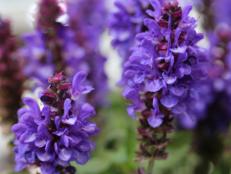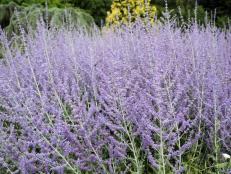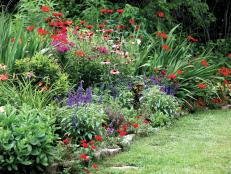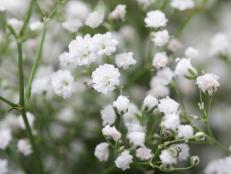Are Mums Perennials?
Learn which mums you can count on to color your landscape for years to come.

Wondering if that gorgeous mum you bought is a perennial? You’re not alone. Mums are one of the more confusing plant groups (even their botanical name has changed several times). There are potted florist mums, which look just like garden (hardy) mums and even share the same botanical name (Chrysanthemum x morifolium)—and they’re perennials, but their survival depends on when you get them and where you live. Garden mums, also known as hardy mums, are perennial mums.
Cut-flower chrysanthemums, like spider mums or football mums, are perennials in Zones 5 to 9, and these types are becoming easier to find for sale online. And then there are the annual mums, yellow daisy (Chrysanthemum multicaule) and painted daisy (which has two botanical names: Chrysanthemum carinatum or Chrysanthemum tricolor). Is it any wonder you’re feeling a bit confused? So when you ask the question, “Are mums perennials?” the answer is a distinct yes—and no.
The group of mums that are hardy actually go by two different common names: garden mums and hardy mums. Garden mums is the wording of choice, and these are the gorgeous flowering plants you see at garden centers in fall displays with pumpkins and gourds. Garden mums boast intense flower power and bold petal hues, including shades like russet, copper, gold, violet and orange.
Garden mums—the reliably perennial mums—are hybrids of Korean chrysanthemums (Chrysanthemum indicum), which are usually hardy in Zones 4 to 8. The vast majority of garden mums (Chrysanthemum x morifolium) are hardy in Zones 5 to 9, although there’s a trick to getting those beautiful fall bloomers to overwinter successfully.
Mums 101: When To Plant and How To Grow Chrysanthemums
Mums can give you color until the cold comes. Here’s how to make the queen of autumn gardens thrive.
Perennial mums have two requirements for them to survive winter: early planting and excellent drainage. Early planting means the minute you see those spectacular mum pans (shallow pots) at garden centers, you need to buy them, bring them home and plant them. Aim to get them in the ground at the very start of fall (that’s early September in regions with cold winters—Zones 4-5). In fact, in cold regions the very best and ideal time to plant perennial mums is spring, but early fall is also a good window.
The second key to successful overwintering is good drainage. Perennial mums (garden mums) survive winter only when drainage is excellent. Add compost to planting holes and beds no matter what type of soil you have—heavy clay or well-drained loam. It’s worth the effort to ensure your garden mum snoozes through winter without dying.
There’s one last piece to the garden mum puzzle you should know. You may see some plant tags stuck in a garden mum pot that say “Dendranthema.” This is a botanical name that was being used for hardy garden mums, but that’s now been reverted back to “Chrysanthemum” by the official plant-naming folks.
Growing Garden Mums
Start with the right spot. Tuck garden mums into the proper condition, and they’ll thrive. When planting mums, select a sunny spot. The more sun mums receive, the more flowers they’ll produce. Garden mums in locations with less light tend to get floppy and need staking. Aim for six hours of sun minimum.
Soil should drain well. Growing mums, like many plants, becomes an exercise in soil improvement if you have heavy, poorly draining soil that contains a lot of clay. Work plenty of organic matter into planting beds in heavy soil. Even in soil that drains well, it’s a good idea to add organic matter. Garden mums crave good drainage.
Avoid overcrowding. Follow spacing recommendations on pot labels when you’re planting mums. These pretty fall flowers don’t deal well with overcrowding. They tend to have shallow roots and don’t compete well with other plants.
Keep mums moist. When growing mums, aim to keep soil moist enough to avoid leaf wilting. Because mums are shallow-rooted, they’re more sensitive to soil drying out. Avoid overwatering, though, or you’ll kill the plants.
Use mulch. Adding a mulch layer to soil helps maintain soil moisture and insulates a garden mum’s shallow root system. Aim for a 2-inch-thick layer, unless you have sandy soil or a garden where summers really sizzle. Then it’s okay to use up to 3 inches of mulch. A good mulch layer can also help protect plant crowns in winter.
Feed mums regularly. For established mums, fertilize in spring as new growth is emerging. Use a common landscape fertilizer with numbers like 5-10-10. If you’re planting mums in spring, fertilize using a product like 5-10-10. This is a common fertilizer and should be easy to find. If you’re planting mums in fall that you intend to yank and compost once frost hits, don’t fertilize at planting time with anything. If you’re planting mums in fall that you intend to overwinter, give plants a high-phosphorus fertilizer to promote strong root growth.
Tuck them in for winter. After a killing frost, clip faded flowers on established garden mums. Don’t trim any stems, though. They help protect the crown through winter. Plan to remove those stems in spring. Pile 3 to 4 inches of mulch over the entire plant, working it down between the stems. Use something like straw or shredded bark that won’t pack down. In spring, remove mulch as new growth begins.
Divide plants. Dig perennial garden mums every few years and divide them to keep growth strong and vigorous. To avoid diminishing the flower show, divide mums in early spring, just as new shoots appear.















































